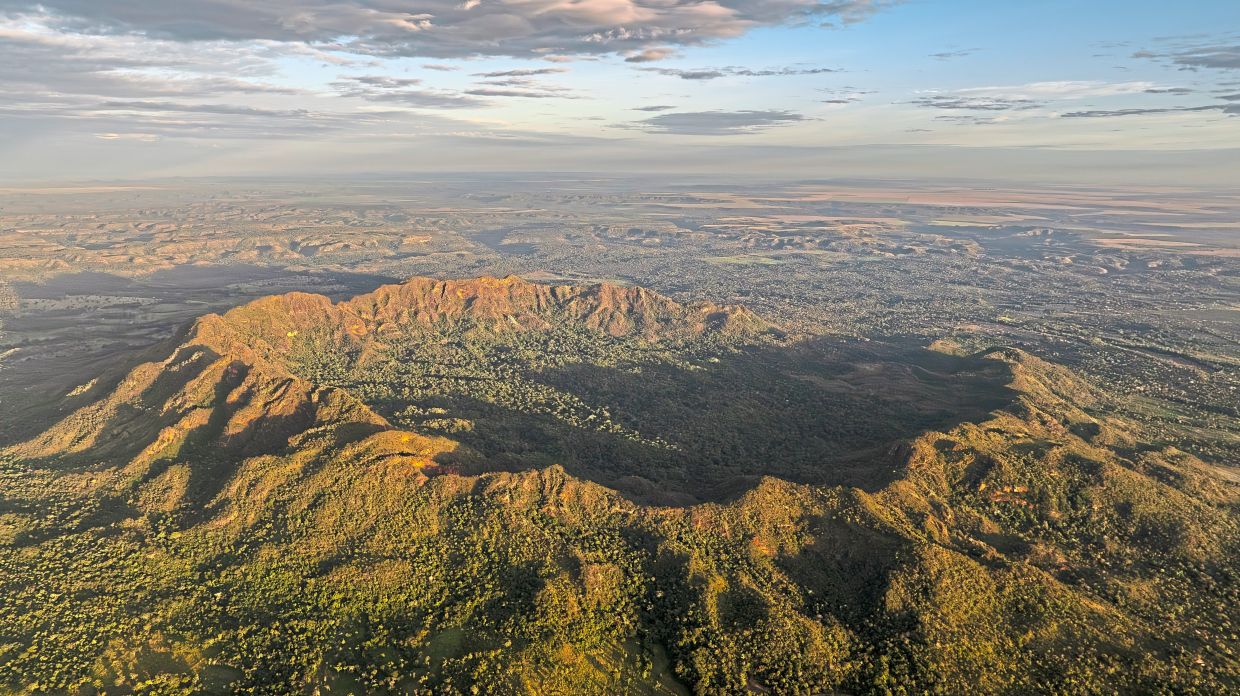IN villages and tile-roofed homes across the vast expanse of Brazil’s countryside, rumours swirl: tales of lights in the sky, prices whispered over WhatsApp chats and collectors arriving from distant lands.
Since a meteorite fell near his home three years ago, Adriano Gomes, an evangelical Christian pastor living in tiny rural Jacilandia in the midwestern state of Goias, recently found himself at the centre of growing public curiosity.
“It came sounding like a plane,” he said. “I was afraid of even touching it, not knowing what it was.”
Gomes knew the meteorite was valuable. Everyone had told him so – the hunters who came knocking, the online forums buzzing with speculation, even a collector from Sao
Paulo who offered him cash.
In May, he was visited by Elizabeth Zucolotto and Elisa Rocha, both geologists and members of As Meteoriticas, an all-female team of scientists devoted to preserving and expanding Brazil’s national meteorite collection.
The group, whose core members also include Amanda Tosi, an astrochemist, and Diana Paula Andrade, an astronomer, journeys to far-flung regions to recover fallen space rocks and educate communities about their scientific significance.
Over coffee, Zucolotto and Rocha examined the stony meteorite, which is slightly larger than a tennis ball and weighs about 170g.
The two geologists said it is a chondrite composed of ancient cosmic dust and tiny molten droplets. These formations are among the oldest solid materials in the solar system.
Zucolotto and Rocha were uneasy about whether Gomes would part with it for a price they could afford.
“We’re not trying to take anything from you,” Zucolotto said. “We’re trying to keep it here – in Brazil, in Goias – for science, for everyone that needs it for research.”
In recent years, meteorites have ignited a quiet conflict in Brazil. Scientists seek to study them, collectors hope to buy them and the often rural residents find themselves caught in the middle.
Zucolotto, as curator of Brazil’s premier meteorite collection at the National Museum in Rio de Janeiro, said there was significant scientific value in meteorites for nations such as Brazil.
“It’s like deploying to the moon, Mars or beyond without needing to spend billions,” she said.
There are also educational benefits of preserving specimens for public use.
Before visiting Gomes, Zucolotto and Rocha stopped at a local school. Their mission was to bring meteorites, and the cosmos, to classrooms as part of a government-funded science outreach campaign.
“We show them what a meteorite is,” Rocha said, “so that if one falls in their yard, they’ll know it’s not just money – it’s knowledge.”
The geologists displayed specimens on three plastic tables. Rocha held a chondrite to a magnet, and a boy flinched as the stone clicked forward. A girl gasped at another space rock fragment.
“What’s Earth’s core made of?” Rocha asked.
“Iron and nickel,” came a voice. Ianara Reis smiled before reaching timidly for her prize.
The debate around meteorite ownership in Brazil reignited in August 2020. More than 80kg of meteorites fell from the sky over Santa Filomena in Pernambuco state, setting off a gold rush for space rocks.
One was a 38kg chondrite. The ancient specimen was estimated to have formed 4.56 billion years ago and contained rare minerals such as troilite.
Residents swiftly gathered fragments that some sold for thousands of dollars, causing a frenzy that drew collectors from around the world.
Zucolotto and Tosi flew in from Rio de Janeiro, more than 1,600km away. They met a local bar owner who presented another specimen, a rare chondrite that was black with conical grooves and burnt-orange streaks. The stone had crashed through his roof days earlier.
“Most chondrites look the same – black, dull, nothing special,” Tosi said. But this one’s features, she said, made it “a masterpiece.”
Then the race escalated. Foreign speculators began arriving, offering cash and buying aggressively. Cars with plates from other Brazilian states pulled in. Groups of men knocked on doors to entice families with prices many had never imagined.
A collector from the United States bought the masterpiece rock from the bar owner.
After negotiations that included the director of the National Museum in Rio, an agreement was reached to transfer the stone to the museum, but only if the Meteoriticas reimbursed the buyer for about US$3,200.
The scientists scrambled. Zucolotto called her son in Rio and asked him to fly in with cash. She and Tosi then raced through back roads, stopping at one bank branch after another to withdraw the rest.
In the end, they managed to secure the cash and acquire the meteorite, which is now on display in Rio, with smaller fragments stored for study at the Federal University of Goias.
After the scramble in Santa Filomena, Rodrigo Vesule, a space law researcher, and the Meteoriticas started a campaign to prevent further loss of Brazil’s scientific heritage.
Working with the Brazilian Geological Society, Vesule is pushing for legislation that would classify meteorites as national scientific assets – regulating, but not prohibiting, their trade.
“It’s not about confiscation,” Vesule said, “but about creating legal certainty and promoting responsible stewardship.”
Not everyone is convinced. Collectors including Andre Moutinho worry that the law could have the effect of criminalising past activities conducted in good faith.
An IT engineer and amateur astronomer based in Sao Paulo, Moutinho has tracked every recent major meteorite event in Brazil. Like many collectors, he has been watching the unfolding legislation with unease.
“If we don’t acknowledge the role collectors played in finding, documenting and preserving these meteorites, we risk alienating a whole community,” he said.
“I’m probably Brazil’s biggest collector, and I don’t feel my voice was heard.”
Back in Jacilandia, Zucolotto and Rocha reached the end of negotiations with Gomes over the meteorite that fell near his home three years earlier.
Zucolotto described the stone’s epic journey – its ancient origins, its scientific rarity and its value that, in her view, exceeds any price tag.
“I think it belongs with you,” Gomes said. “If you can match the last offer I got.”
The geologists scraped together the agreed-upon price – the equivalent of a bit more than US$900 – and drove off with the fallen stone, relieved. — ©2025 The New York Times Company
This article originally appeared in The New York Times






